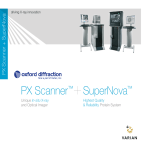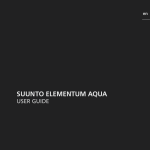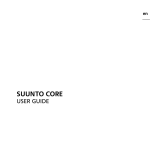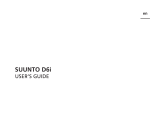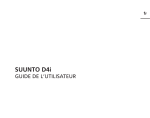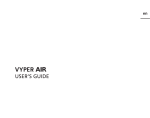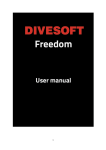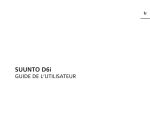Download Suunto DX User's Guide
Transcript
en SUUNTO DX USER’S GUIDE 1. WELCOME TO THE WORLD OF SUUNTO DIVE COMPUTERS ................. 8 2. WARNINGS, CAUTIONS, AND NOTES .............................................. 9 3. SUUNTO USER INTERFACE ........................................................ 19 3.1. Navigating in the menus ......................................................... 20 3.2. Button symbols and functions ................................................... 22 4. GETTING STARTED .................................................................. 24 4.1. TIME mode settings .............................................................. 24 4.1.1. Setting the alarm ............................................................ 26 4.1.2. Setting the time .............................................................. 26 4.1.3. Setting the dual time ........................................................ 27 4.1.4. Setting the date .............................................................. 27 4.1.5. Setting the units ............................................................. 27 4.1.6. Setting the backlight ........................................................ 28 4.1.7. Setting the contrast ......................................................... 28 4.1.8. Setting the tones ............................................................ 29 4.2. Stopwatch ......................................................................... 29 4.3. AC water contacts ................................................................ 30 4.4. Learning how to use your compass ............................................ 31 4.4.1. Compass display ............................................................ 32 4.4.2. Locking a bearing ........................................................... 33 4.4.3. Compass settings ........................................................... 34 5. BEFORE DIVING ...................................................................... 38 TM 5.1. The Suunto Fused RGBM .................................................... 39 5.2. Emergency ascents .............................................................. 39 3 5.3. Dive computer limitations ........................................................ 5.4. Audible and visual alarms ....................................................... 5.5. Error conditions ................................................................... 5.6. Wireless transmission ............................................................ 5.6.1. Installing the wireless transmitter .......................................... 5.6.2. Pairing and code selection ................................................. 5.6.3. Transmitting data ............................................................ 5.7. Accessing DIVE mode ........................................................... 5.8. DIVE mode settings .............................................................. 5.8.1. Setting the CC gases ....................................................... 5.8.2. Setting the open-circuit gases ............................................. 5.8.3. Setting the Set Point values ............................................... 5.8.4. Setting the personal/altitude adjustments ................................ 5.8.5. Setting the tank pressure pairing .......................................... 5.8.6. Setting the tank pressure alarm ........................................... 5.8.7. Setting the depth alarm ..................................................... 5.8.8. Setting the dive-time alarm ................................................. 5.8.9. Setting the sample rate ..................................................... 5.8.10. Setting the deep stops .................................................... 5.8.11. Setting the air time ......................................................... 5.9. Before diving in the MIXED or CCR mode ..................................... 5.9.1. Default gas mix settings .................................................... 5.10. Activation and pre-checks ...................................................... 5.10.1. DIVE mode activation ..................................................... 4 40 40 45 46 46 47 50 52 52 54 55 57 61 61 62 63 63 64 64 65 65 66 66 67 5.10.2. Battery power indication .................................................. 5.10.3. Diving at altitude ........................................................... 5.10.4. Personal adjustments ..................................................... 5.11. Safety Stops ..................................................................... 5.11.1. Recommended Safety Stops ............................................. 5.11.2. Mandatory Safety Stops .................................................. 5.12. Deep stops ....................................................................... 6. DIVING .................................................................................. 6.1. Diving in the AIR mode (DIVE Air) .............................................. 6.1.1. Basic dive data .............................................................. 6.1.2. Bookmark .................................................................... 6.1.3. Tank pressure data .......................................................... 6.1.4. Ascent rate indicator ........................................................ 6.1.5. Safety Stops and Deep Stops ............................................. 6.1.6. Stopwatch (Timer) ........................................................... 6.1.7. Decompression dives ....................................................... 6.2. Diving in MIXED or CCR mode ................................................. 6.2.1. Oxygen and helium displays ............................................... 6.2.2. Oxygen limit fraction (OLF%) .............................................. 6.2.3. Gas change and multiple breathing gas mixes in MIXED mode ....... 6.2.4. Set point and diluent/gas mix change in CCR mode .................... 6.2.5. Hyperoxic and hypoxic mixes in CCR .................................... 6.3. Diving in the GAUGE mode (DIVE Gauge) .................................... 7. AFTER DIVING ......................................................................... 69 70 71 74 74 75 76 78 78 79 80 81 83 84 84 85 90 90 92 92 93 96 96 98 5 7.1. Surface interval ................................................................... 98 7.2. Dive numbering ................................................................... 99 7.3. Repetitive dive planning ........................................................ 100 7.4. Flying after diving ............................................................... 100 7.5. DIVE PLANNING mode (PLAN NoDec) ...................................... 101 7.5.1. Dive numbering shown during dive planning ........................... 103 7.6. MEMORY mode ................................................................. 103 7.6.1. Dive logbook (MEM Logbook) ............................................ 104 7.6.2. Dive history ................................................................ 107 7.7. Suunto DM4 ..................................................................... 107 7.8. Movescount ...................................................................... 108 8. CARE AND MAINTENANCE OF MY SUUNTO DIVING COMPUTER ......... 110 9. BATTERY REPLACEMENT ......................................................... 113 9.1. Computer battery replacement ................................................ 113 9.2. Wireless transmitter battery replacement .................................... 114 9.2.1. Transmitter battery kit ..................................................... 114 9.2.2. Required tools .............................................................. 114 9.2.3. Replacing the transmitter battery ........................................ 114 10. TECHNICAL DATA .................................................................. 116 10.1. Technical specifications ....................................................... 116 10.2. Suunto decompression model development ................................ 120 10.2.1. Diver safety ............................................................... 121 10.2.2. Altitude diving ............................................................. 122 10.3. Oxygen exposure .............................................................. 122 6 10.4. Isobaric counterdiffusion (ICD) ............................................... 11. INTELLECTUAL PROPERTY ...................................................... 11.1. Trademark ...................................................................... 11.2. Copyright ........................................................................ 11.3. Patent notice ................................................................... 12. DISCLAIMERS ...................................................................... 12.1. CE ............................................................................... 12.2. EN 13319 ....................................................................... 12.3. EN 250 / FIOH ................................................................. 13. SUUNTO LIMITED WARRANTY ................................................. 14. DISPOSAL OF THE DEVICE ...................................................... GLOSSARY .............................................................................. 124 125 125 125 125 126 126 126 126 127 129 130 7 1. WELCOME TO THE WORLD OF SUUNTO DIVE COMPUTERS Suunto DX wristop dive computer is designed to help you get the most out of your diving. Suunto DX is the world’s first wristop sized dive computer to integrate rebreather and trimix compatibility, a tilt-compensated 3D digital compass, and wireless tank pressure reception into one compact unit. It simplifies your diving experience because all the information you need relating to depth, time, optional tank pressure, decompression status, and direction is now available on one easy-to-read screen. The Suunto DX User's Guide contains vitally important information which enables you to become familiar with your Suunto wristop dive computer. To understand the use, displays, and limitations of the instrument before using it, please read this user's guide carefully, and save it for further reference. Note also that a glossary is included at the back of the user's guide to help you understand dive-specific terminology. 8 2. WARNINGS, CAUTIONS, AND NOTES Throughout this user's guide, important safety icons are displayed. Three classifications are used to separate these icons by their order of importance: WARNING is used in connection with a procedure or situation that may result in serious injury or death CAUTION is used in connection with a procedure or situation that will result in damage to the device NOTE is used to emphasize important information Before you go on to read the user's guide itself, it is extremely important that you read the following warnings. These warnings are intended to maximize your safety while using Suunto DX and must not be ignored. WARNING YOU MUST READ the leaflet and user guide for your dive computer. Failure to do so may lead to improper use, serious injury or death. WARNING ALLERGIC REACTIONS OR SKIN IRRITATIONS MAY OCCUR WHEN PRODUCT IS IN CONTACT WITH SKIN, EVEN THOUGH OUR PRODUCTS COMPLY WITH INDUSTRY STANDARDS. IN SUCH EVENT, STOP USE IMMEDIATELY AND CONSULT A DOCTOR. 9 10 WARNING NOT FOR PROFESSIONAL USE! Suunto dive computers are intended for recreational use only. The demands of commercial or professional diving may expose the diver to depths and conditions that tend to increase the risk of decompression sickness (DCS). Therefore, Suunto strongly recommends that the device not be used for any commercial or professional diving activities. WARNING ONLY DIVERS TRAINED IN PROPER USE OF SCUBA DIVING EQUIPMENT SHOULD USE A DIVE COMPUTER! No dive computer can replace the need for proper dive training. Insufficient or improper training may cause a diver to commit errors that may lead to serious injury or death. WARNING THERE IS ALWAYS A RISK OF DECOMPRESSION SICKNESS (DCS) FOR ANY DIVE PROFILE EVEN IF YOU FOLLOW THE DIVE PLAN PRESCRIBED BY DIVE TABLES OR A DIVE COMPUTER. NO PROCEDURE, DIVE COMPUTER OR DIVE TABLE WILL PREVENT THE POSSIBILITY OF DCS OR OXYGEN TOXICITY! An individual’s physiological make up can vary from day to day. The dive computer cannot account for these variations. You are strongly advised to remain well within the exposure limits provided by the instrument to minimize the risk of DCS. As an added measure of safety, you should consult a physician regarding your fitness before diving. WARNING SUUNTO STRONGLY RECOMMENDS THAT SPORT DIVERS LIMIT THEIR MAXIMUM DEPTH TO 40 M/130 FT OR TO THE DEPTH CALCULATED BY THE COMPUTER BASED ON THE SELECTED O2% AND A MAXIMUM PO2 OF 1.4 BAR! Exposure to greater depths increases the risk of oxygen toxicity and decompression sickness. WARNING DIVES WITH REQUIRED DECOMPRESSION STOPS ARE NOT RECOMMENDED. YOU SHOULD ASCEND AND BEGIN DECOMPRESSION IMMEDIATELY WHEN THE DIVE COMPUTER SHOWS YOU THAT A DECOMPRESSION STOP IS REQUIRED! Note the blinking ASC TIME symbol and the upward pointing arrow. WARNING USE BACK-UP INSTRUMENTS! Ensure that you use back-up instrumentation, including a depth gauge, submersible pressure gauge, timer or watch, and have access to decompression tables whenever diving with the dive computer. WARNING PERFORM PRE-CHECKS! Always activate and check the device before diving in order to ensure that all Liquid Crystal Display (LCD) segments are completely displayed, the device has not run out of battery power, and that the oxygen, altitude, personal, and Safety/Deep Stop are correct. 11 12 WARNING YOU ARE ADVISED TO AVOID FLYING ANY TIME THE COMPUTER COUNTS DOWN THE NO-FLY TIME. ALWAYS ACTIVATE THE COMPUTER TO CHECK THE REMAINING NO-FLY TIME PRIOR TO FLYING! Flying or traveling to a higher altitude within the no-fly time can greatly increase the risk of DCS. Review the recommendations given by Divers Alert Network (DAN). There can never be a flying after diving rule that is guaranteed to completely prevent decompression sickness! WARNING THE DIVE COMPUTER SHOULD NEVER BE TRADED OR SHARED BETWEEN USERS WHILE IT IS IN OPERATION! Its information will not apply to someone who has not been wearing it throughout a dive or sequence of repetitive dives. Its dive profiles must match that of the user. If it is left on the surface during any dive, the dive computer will give inaccurate information for subsequent dives. No dive computer can take into account dives made without the computer. Thus, any diving activity up to four days prior to initial use of the computer may cause misleading information and must be avoided. WARNING DO NOT EXPOSE ANY PART OF YOUR DIVE COMPUTER TO ANY GAS MIX CONTAINING MORE THAN 40% OXYGEN! Enriched air with greater oxygen content presents a risk of fire or explosion and serious injury or death. WARNING THE DIVE COMPUTER WILL NOT ACCEPT FRACTIONAL PERCENTAGE VALUES OF OXYGEN CONCENTRATION. DO NOT ROUND UP FRACTIONAL PERCENTAGES! For example, 31.8% oxygen should be entered as 31%. Rounding up will cause nitrogen percentages to be understated and will affect decompression calculations. If there is a desire to adjust the computer to provide more conservative calculations, use the personal adjustment feature to affect decompression calculations or reduce the PO2 setting to affect oxygen exposure according to the entered O2% and PO2 values. As a safety precaution, the oxygen calculations in the dive computer are made with an oxygen percentage of 1% + set O2%. WARNING SET THE CORRECT ALTITUDE ADJUSTMENT MODE! When diving at altitudes greater than 300 m/1000 ft, the Altitude Adjustment feature must be correctly selected in order for the computer to calculate the decompression status. The dive computer is not intended for use at altitudes greater than 3000 m/10000 ft. Failure to select the correct Altitude Adjustment setting or diving above the maximum altitude limit will result in erroneous dive and planning data. 13 14 WARNING SET THE CORRECT PERSONAL ADJUSTMENT MODE! Whenever it is believed that factors that tend to increase the possibility of DCS exist, it is recommended that you use this option to make the calculations more conservative. Failure to select the correct Personal Adjustment setting will result in erroneous dive and planning data. WARNING DO NOT EXCEED THE MAXIMUM ASCENT RATE! Rapid ascents increase the risk of injury. You should always make the Mandatory and Recommended Safety Stops after you have exceeded the maximum recommended ascent rate. If this Mandatory Safety Stop is not completed the decompression model will penalize your next dive(s). WARNING YOUR ACTUAL ASCENT TIME MAY BE LONGER THAN DISPLAYED BY THE INSTRUMENT! The ascent time will increase if you: • remain at depth • ascend slower than 10 m/min / 33 ft/min or • make your decompression stop deeper than at the ceiling These factors will also increase the amount of breathing gas required to reach the surface. WARNING NEVER ASCEND ABOVE THE CEILING! You must not ascend above the ceiling during your decompression. In order to avoid doing so by accident, you should stay somewhat below the ceiling. WARNING DO NOT DIVE WITH A CYLINDER OF ENRICHED AIR IF YOU HAVE NOT PERSONALLY VERIFIED ITS CONTENTS AND ENTERED THE ANALYZED VALUE INTO YOUR DIVE COMPUTER! Failure to verify cylinder contents and enter the appropriate O2% into your dive computer will result in incorrect dive planning information. WARNING DO NOT DIVE WITH A GAS IF YOU HAVE NOT PERSONALLY VERIFIED ITS CONTENTS AND ENTERED THE ANALYZED VALUE INTO YOUR DIVE COMPUTER! Failure to verify cylinder contents and enter the appropriate gas values where applicable into your dive computer will result in incorrect dive planning information. WARNING Diving with gas mixtures exposes you to risks that are different from those associated with diving with standard air. These risks are not obvious, and require training to understand and avoid. Risks include possible serious injury or death. 15 16 WARNING Traveling to a higher elevation can temporarily cause a change in the equilibrium of dissolved nitrogen in the body. It is recommended that you acclimatize to the new altitude by waiting at least three hours before diving. WARNING WHEN THE OXYGEN LIMIT FRACTION INDICATES THAT THE MAXIMUM LIMIT IS REACHED, YOU MUST IMMEDIATELY TAKE ACTION TO REDUCE OXYGEN EXPOSURE. Failure to take action to reduce oxygen exposure after the warning is given can rapidly increase the risk of oxygen toxicity, injury, or death WARNING If there are several divers using the dive computer with wireless transmission, always ensure that each diver is using a different code before starting the dive. WARNING Personal adjustment setting P0–P-2 causes a high risk of DCS, or other personal injury, and death. WARNING Using the Suunto Dive Planner software is not a substitute for proper dive training. Diving with mixed gases has dangers that are not familiar to divers diving with air. To dive with trimix, triox, heliox and nitrox or all of them, divers must have specialized training for the type of diving they are doing. WARNING Always use realistic SAC rates and conservative turn pressures during dive planning. Overly optimistic or erroneous gas planning can result in the exhaustion of breathing gas during decompression or in a cave or a wreck. WARNING ENSURE THE WATER RESISTANCE OF THE DEVICE! Moisture inside the device and/or battery compartment may seriously damage the unit. Only an authorized SUUNTO service center should do service activities. WARNING Do not use Suunto USB Cable in areas where flammable gases are present. Doing so may cause an explosion. WARNING Do not disassemble or remodel Suunto USB Cable in any way. Doing so may cause an electric shock or fire. WARNING Do not use if Suunto USB Cable or parts are damaged. CAUTION Only use at specified temperatures. CAUTION Only use Suunto USB Cable with Suunto dive computers. Check compatibility before use. 17 18 CAUTION Only use a clean and dry Suunto USB Cable. Clean and dry the connector surfaces before use to prevent damage to the Suunto dive computer. CAUTION Only attach Suunto USB Cable to the data transfer contact on the Suunto dive computer. CAUTION Never lift or carry your cylinder by holding the wireless tank pressure transmitter as this may break the cover and cause flooding of the unit. If your cylinder falls down with the transmitter attached to the regulator first stage, ensure that the transmitter has not been damaged before diving with it. NOTE It is not possible to change to AIR mode after a dive in MIXED or CCR mode, before the No-fly time has elapsed. When planning both air and mixed gas/CCR dives during the same dive series, you should set the instrument in MIXED mode and modify the gas mix accordingly. NOTE In GAUGE mode the no-fly time is always 48 hours. 3. SUUNTO USER INTERFACE Present Depth Active Water Contact Indicator Daily Alarm Indicator Dive Alarm Indicator Diver Attention Symbol Current Time Display Mode Indicator No-Decompression Time Total Ascent Time Ceiling Depth Remaining Air Time Safety/Deep Stop Time Surface Interval Time No-Fly Time Compass Display Tissue Saturation Graph Set Point (CCR Mode) No-Fly Icon Safety Stop Indicator Tank Pressure Bar Graph Wireless Transmission Indicator Ascent Rate Bar Graph Date Dual Time Maximum Depth O2/He% (Mixed and CCR Mode) Time Tank Pressure Low Battery Warning NOTE Seconds Display Stopwatch Weekday Dive Time Temperature PO2% (Mixed and CCR Mode) OLF% (Mixed and CCR Mode) If no button is pressed for 5 minutes, the dive computer beeps and returns to the TIME mode automatically. 19 3.1. Navigating in the menus Suunto DX has four main operating modes - TIME mode (TIME), DIVE mode (DIVE), PLAN mode (PLAN), and MEMORY mode (MEM). It also has a COMPASS submode, which can be activated from either TIME or DIVE modes. To toggle between the main modes, press the MODE button. To select a submode in DIVE and MEM modes, press the UP/DOWN buttons. 20 COMPASS SETTINGS Calibrate Declination Timeout TIME DIVE LIGHT SETTINGS Alarm Time Dual Time Date Units Backlight Contrast Tones SETTINGS CC Gases OC Gases / Gases Set Point Personal / Altitude Tank Press Pairing Tank Press Alarm Depth Alarm Dive Time Alarm Sample Rate Deepstop Air Time PLAN LIGHT SUB-MODES Air Mixed CCR Gauge Off MEM LIGHT LIGHT SUB-MODES Logbook History 21 3.2. Button symbols and functions The table below explains the main functions of the dive computer's buttons. The buttons and their use is explained in more detail in the relevant sections of the user's guide. Table 3.1. Button symbols and functions Symbol Button Press Main functions 22 MODE Short Switch between main modes Switch from submode to main mode Activate backlight in DIVE mode MODE Long Activate backlight in other modes Activate stopwatch in DIVE mode SELECT Short Select a submode Select and accept settings Select stopwatch to stop or start in DIVE mode SELECT Long Activate compass in TIME and DIVE modes Symbol Button Press Main functions UP Short Toggle between alternative displays Change submode Increase values UP Long Activate gas switching in MIXED and CCR mode View gas selection in SURFACE mode (MIXED and CCR only). View set points and switch depths in SURFACE mode (CCR only). DOWN Short Toggle between alternative displays Change submode Decrease values DOWN Long Enter Setting mode Toggle between ceiling and remaining air time display 23 4. GETTING STARTED To get the most out of your Suunto DX, use some time to personalize it and really make it YOUR computer. Set the correct time and date, as well as the alarms and tones, unit and backlight settings. Then, calibrate and test the compass function. Suunto DX is a very user-friendly dive computer, and you will quickly become familiar with its functions. Make absolutely sure that you know your computer and have it set up as you want it BEFORE getting into the water. 4.1. TIME mode settings The first thing to do with your Suunto DX is to set the TIME mode shortcuts: the time, alarm, dual time, date, units, backlight, contrast, and tones. The figure below shows how to toggle between different shortcuts in the TIME mode: BETWEEN DIVES YOU CAN CHECK YOUR SURFACE INTERVAL TIME FROM THE TIME MODE SHORTCUTS! 24 NOTE The seconds display reverts to date display after 5 minutes in order to save battery power. NOTE The display is illuminated by holding down the MODE button for more than 2 seconds. Now that after you know how to toggle between the shortcuts, you can start to set them. The figure below shows how to enter the TIME Settings menu. USE UP AND DOWN BUTTONS TO TOGGLE BETWEEN ALARM, TIME, DUAL TIME, DATE, UNITS, CONTRAST, TONES AND VERSION. 25 4.1.1. Setting the alarm The dive computer has a daily alarm function. The alarm can be set to be activated only once, on weekdays or every day. When the daily alarm activates, the screen blinks and the alarm sounds for 60 seconds. Press any button to stop the alarm. ADJUST WITH UP AND DOWN BUTTONS. ACCEPT WITH SELECT BUTTON. 4.1.2. Setting the time In the Time setting mode, you are able to set the hour, minute, and second, as well as choose between a 12 and 24 hour display. ADJUST WITH UP AND DOWN BUTTONS. ACCEPT WITH SELECT BUTTON. 26 4.1.3. Setting the dual time In the Dual Time setting mode, you are able to select the hour and minute of a dual time, which is useful when traveling to a different time zone. ADJUST WITH UP AND DOWN BUTTONS. ACCEPT WITH SELECT BUTTON. 4.1.4. Setting the date In the Date setting mode, you are able to set the year, month, and day. The day of the week is automatically calculated in accordance with the date. In metric units the date is presented as DD/MM, and in imperial units as MM/DD. ADJUST WITH UP AND DOWN BUTTONS. ACCEPT WITH SELECT BUTTON. 4.1.5. Setting the units In the Units setting mode, you are able to choose whether the units are displayed in either the metric or imperial system (meters/feet, Celsius/Fahrenheit, and so on). 27 ADJUST WITH UP AND DOWN BUTTONS. ACCEPT WITH SELECT BUTTON. 4.1.6. Setting the backlight In the Backlight setting mode, you are able to turn the backlight ON or OFF and to define how long it stays on for (5, 10, 20, 30, or 60 seconds). NOTE When the backlight is turned OFF, it does not illuminate when an alarm sounds. ADJUST WITH UP AND DOWN BUTTONS. ACCEPT WITH SELECT BUTTON. 4.1.7. Setting the contrast In the Contrast setting mode, you are able to set the contrast of the display (the value range is between 0 and 10). 28 ADJUST WITH UP AND DOWN BUTTONS. ACCEPT WITH SELECT BUTTON. 4.1.8. Setting the tones In the Tones setting mode, you are able to activate or deactivate the tones. ADJUST WITH UP AND DOWN BUTTONS. ACCEPT WITH SELECT BUTTON. NOTE When the tones are off, there are no audible alarms. 4.2. Stopwatch The Stopwatch function in Suunto DX measures elapsed and split times. A separate stopwatch (dive timer) can also be used in the DIVE mode. For more information, refer to Section 6.1.6. Stopwatch (Timer). 29 USE DOWN BUTTON TO START STOPWATCH AND TAKE A SPLIT TIME. THE UP BUTTON STOPS THE STOPWATCH. IF YOU HAVE TAKEN SPLIT TIMES, YOU CAN SCROLL THEM BY SHORT PRESSING THE UP BUTTON. LONG PRESSING UP RESETS THE STOPWATCH. 4.3. AC water contacts The water and data transfer contact is located on the side of the case. When submerged, the water contact poles are connected by the conductivity of the water and the “AC” symbol appears on the display. The AC text is shown until the water contact deactivates. AC APPEARS IN THE TOP RIGHT CORNER OF THE DISPLAY, WHEN THE DIVE COMPUTER IS IN CONTACT WITH WATER. THIS ALSO ACTIVATES THE DIVE MODE. 30 Contamination or dirt on the water contact may prevent this automatic activation. Therefore, it is important that the water contact is kept clean. The contact can be cleaned with fresh water and a soft brush, for example a tooth brush. NOTE Water or moisture build-up around the water contact may cause the contact to activate automatically. This can happen, for example, when washing your hands or sweating. If the water contact activates in the TIME mode, the AC symbol will appear on the display, and will be shown until the water contact deactivates. To save battery power, you should deactivate the water contact by cleaning it and/or drying it with a soft towel. 4.4. Learning how to use your compass Suunto DX integrates a digital compass that can be used both while diving and and on the surface, and can be accessed by long-pressing the SELECT button. 31 IF ACCESSED FROM TIME MODE, TIME AND BEARING ARE DISPLAYED AT THE BOTTOM OF THE SCREEN. ACCESSED FROM DIVE MODE, CURRENT DEPTH, AND TIME OR MAXIMUM DEPTH, TANK PRESSURE, AS WELL AS BEARING OR DIVE TIME OR TEMPERATURE ARE DISPLAYED. NOTE When accessed from DIVE mode, toggle between the alternative displays by pressing the UP/DOWN buttons. 4.4.1. Compass display The Suunto DX displays the compass as a graphical representation of a compass rose. The rose displays the cardinal and half cardinal points, in addition to which, the current bearing is also displayed numerically. 32 4.4.2. Locking a bearing A bearing can be locked to help you follow a selected course, and directional arrows point towards the locked bearing. The last locked bearing is stored and is available the next time the compass is activated. In the DIVE mode the locked bearings are also stored in the log. TO LOCK A BEARING, PRESS SELECT. The Suunto DX also provides help for navigating square and triangular patterns, as well as navigating a return heading. This is made possible by following graphical symbols in the center of the compass display: Table 4.1. Locked bearing symbols Symbol Explanation You are traveling towards the locked bearing You are 90 (or 270) degrees from the locked bearing 33 Symbol Explanation You are 180 degrees from the locked bearing You are 120 (or 240) degrees from the locked bearing 4.4.3. Compass settings You can define the compass settings (Calibration, Declination and Timeout) in the COMPASS mode: Calibration Because of changes in the surrounding magnetic field, the Suunto DX electronic compass occasionally needs to be re-calibrated. During the calibration process, the compass adjusts itself to the surrounding magnetic field . As a basic rule, you should calibrate the compass whenever it does not seem to operate properly, or after replacing the dive computer's battery. 34 NOTE The unit will automatically enter the calibration sequence when taken into use for the first time. Strong electromagnetic fields, such as power lines, stereo speakers, and magnets can affect the compass calibration. Therefore, it is advisable to calibrate the compass if your Suunto DX has been exposed to these fields. NOTE When traveling overseas, it is recommended that you recalibrate the compass at the new location before using it. NOTE Remember to hold the Suunto DX level during the calibration process. 35 To calibrate the compass: HOLD THE DEVICE LEVEL AND SLOWLY ROTATE THE UNIT IN A LARGE "INFINITY LOOP" UNTIL THE DEVICE BEEPS AND TEXT PASSED APPEARS. If the calibration fails several times in a row (text “Try Again” appears), it is possible that you are in an area with sources of magnetism, such as large metal objects, power lines or electric appliances. Move to another location and try to calibrate the compass again. If the calibration continues to fail, contact an authorized Suunto service center. Declination You can compensate for the difference between true north and magnetic north by adjusting the compass declination. The declination can be found, for example, from sea charts or topographic maps of the local area. 36 ADJUST WITH UP AND DOWN. ACCEPT WITH SELECT. Time-out You can set the compass time-out minutes. After the set time has passed from the latest button press, the dive computer returns to the TIME or DIVE mode from the COMPASS mode. ADJUST WITH UP AND DOWN. ACCEPT WITH SELECT. You can exit the COMPASS mode also by long pressing the SELECT button. 37 5. BEFORE DIVING Do not attempt to use the dive computer without reading this user's guide in its entirety, including all the warnings. Make sure that you fully understand the use, displays and limitati







































































































































